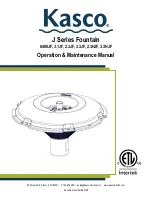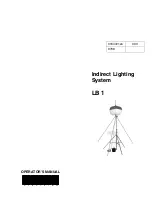
Troubleshooting
Symptom
Possible Cause
Solution
Light does not switch on
when there is movement in
the coverage area.
The power switch is turned off.
Check that the power is switched ON at the circuit
breaker/internal wall switch.
The light fixture is not properly attached to the
mounting plate, if this is a new installation (the pins
are not fully seated in the terminal block).
Re-install the light fixture to the base and ensure
the pins are fully seated in the terminal block.
The circuit wiring is incorrect (if this is a new
installation).
Check the wiring connections, ensure no
connections are loose.
The sensor is aimed in the wrong direction.
Detection zone not properly targeted.
Re-aim the sensor to cover the desired area.
Another light source is causing the unit to think
it is daylight.
Turn off surrounding lights and/or re-aim the
sensor head.
The light comes on during
the day.
Unit is located at shaded area.
Shine a flashlight onto the sensor. If the light turns
off then the fixture is mounted in an area that does
not allow enough light to enter the sensor. Relocate
the product.
The light comes on for no
apparent reason.
The product is wired through a dimmer or timer.
Do not use a dimmer or timer to control the
product. Repelace the dimmer or timer with a
standard on/off wall switch.
Wind is moving trees and bushes in the detection
zone.
Relocate the unit.
Cars in the street are being detected.
Relocate the unit.
Reflective objects (such as swimming pool) in the
coverage area.
Relocate the unit.
Sunlight is falling onto the lens.
Mount unit in a sheltered place.
Unit is sensing motion in the detection zone.
Test the motion sensor by covering up the front
curved lens with cardboard to block the view. If the
light turns off then something in the detection zone
is triggering the sensor. Relocate the unit.
Coverage area of sensor
is poor.
Choose a suitable location for installing the
product, away from trees, hot ventilator dusts,
street lighting and traffic, which may interfere
with its operation.
Relocate the unit.
The lights stay on
continuously.
The sensor may be picking up a heat source, such
as an air vent, dryer vent, or bright painted, heat-
reflective surface.
Relocate the unit.
The product is wired through a dimmer or timer.
Do not use a dimmer or timer to control the
product. Repelace the dimmer or timer with a
standard on/off wall switch.
The unit may be suffering from false
activation.
Cover the sensor lens completely with a thick cloth.
This will prevent the sensor from “seeing” anything.
If the unit now switches off after the set time
duration and does not re-activate, this indicates
that the problem was caused by false activation.
Slightly adjusting the direction / angle of the sensor
head.
Ensure the unit is not positioned to detect
unwanted objects e.g. cars / people using roads /
footpaths next to your property. Occasionally,
wind may activate the sensor. (Sometimes
passages between buildings etc. can cause a
“wind tunnel” effect.).
Relocate the unit.
The unit is operated in the mode of the motion
sensor being deactivated.
To activate the motion sensor.
The lights flash on and off.
Heat or light from the bulbs may be turning the
sensor on and off.
Relocate the unit, away from the light source.
Heat is being reflected from other objects and
may be turning the sensor on and off.
Relocate the unit
Sensor is sensing reflected light from the light
fixture.
1. Change position of light head aim light away from
the reflecting surfaces.
2. Relocate the unit to a different location where it
no longer causes reflected light.
Sensor will not operate at
night.
The level of ambient light in the area may be too
bright to allow operation.
Relocate the unit.
Wiring inside electrical came loose.
After turning off the fixture, reconnect any loose
wiring.
No power is being delivered to the fixture.
Check that circuit breaker and/or wall switch power
is on.
Another light source is causing the unit to think
it is daylight.
Turn off surrounding lights and/or relocate the unit.
Light does not switch off
after set time has elapsed.
The unit is operated in the mode of the motion
sensor being deactivated.
To activate the motion sensor.
When setting the controls
in daylight the detection
distance becomes shorter.
Interference by sunlight.
Re-set controls at night.
Dépannage
Symptôme
Causes possibles
Solutions
L’éclairage ne s’allume pas
lorsqu’il y a un mouvement
dans la zone couverte.
L’interrupteur est éteint.
Vérifier que l’alimentation est activée au niveau du
disjoncteur/de l’interrupteur mural interne.
Le luminaire n’est pas correctement fixé à la
plaque de montage s’il s’agit d’une nouvelle
installation (les broches ne sont pas entièrement
insérées dans le boîtier de raccordement).
Réinstaller le luminaire sur sa base et vérifier que
les broches sont bien insérées dans le boîtier de
raccordement.
Le câblage du circuit est incorrect (s’il s’agit d’une
nouvelle installation).
Vérifier les branchements du câblage, afin de
garantir qu’aucun câble n’est débranché.
Le détecteur est orienté dans la mauvaise
direction. La zone de détection n’est pas
correctement ciblée.
Réorienter le détecteur de manière à couvrir la
zone souhaitée.
Une autre source d’éclairage est détectée par
l’appareil comme étant la lumière du jour.
Éteindre les lumières environnantes et/ou
réorienter la tête du détecteur.
L’éclairage s’allume pendant
la journée.
L’appareil se trouve dans une zone non éclairée.
Éclairer le détecteur avec une lampe torche. Si la
lumière s’éteint, cela signifie que le détecteur du
luminaire est situé dans une zone qui ne reçoit pas
assez de lumière. Déplacer l’appareil.
L’éclairage s’allume sans
raison apparente.
Le produit est relié à l’alimentation par
l’intermédiaire d’un variateur ou d’une minuterie.
Ne pas utiliser de variateur ou de minuterie pour
contrôler le produit. Remplacer le variateur ou la
minuterie par un commutateur mural standard.
Le vent fait bouger les arbres et les arbustes dans
la zone de détection.
Déplacer l’appareil.
Des voitures sont détectées dans la rue.
Déplacer l’appareil.
La zone de détection inclut des objets
réfléchissants (par exemple, une piscine).
Déplacer l’appareil.
La lumière du soleil éclaire directement l’objectif.
Placer l’appareil dans une zone à l’abri du soleil.
L’appareil détecte un mouvement dans la zone de
détection.
Tester le détecteur de mouvement en recouvrant
la lentille frontale incurvée avec du carton pour
bloquer la vue. Si l’éclairage s’éteint, cela signifie
qu’un élément dans la zone de détection déclenche
le détecteur. Déplacer l’appareil.
La zone de couverture
du détecteur n’est pas
suffisante.
Installer le produit dans un endroit approprié,
à l’écart des arbres, des poussières chaudes
déplacées par des systèmes de ventilation, de
l’éclairage public et de la circulation, susceptibles
de l’empêcher de fonctionner correctement.
Déplacer l’appareil.
Les éclairages restent
allumés en permanence.
Le détecteur peut détecter une source de chaleur,
telle qu’une bouche d’aération, une évacuation
d’air de sèche-linge ou une surface peinte
brillante et réfléchissant la chaleur.
Déplacer l’appareil.
Le produit est relié à l’alimentation par
l’intermédiaire d’un variateur ou d’une minuterie.
Ne pas utiliser de variateur ou de minuterie pour
contrôler le produit. Remplacer le variateur ou la
minuterie par un commutateur mural standard.
L’appareil peut être activé par erreur.
Recouvrir entièrement la lentille du détecteur avec
un chiffon épais. Cela empêchera le détecteur
de percevoir quoi que ce soit. Si l’appareil s’éteint
après la durée définie et ne se réactive pas, cela
indique que le problème avait pour origine une
activation non prévue.
Régler progressivement la direction ou l’angle de la
tête du détecteur.
Veiller à ce que l’appareil ne soit pas positionné
de manière à détecter des objets indésirables,
tels que des voitures/personnes empruntant les
routes/trottoirs à proximité de votre propriété.
Le vent peut parfois activer le détecteur. (Les
passages entre les bâtiments, etc., peuvent
parfois provoquer un effet de « soufflerie ».).
Déplacer l’appareil.
Dans le mode de fonctionnement choisi par
l’appareil, le détecteur de mouvement est
désactivé.
Activer le détecteur de mouvement.
Les éclairages s’allument
et s’éteignent de manière
répétée.
La chaleur ou la lumière des ampoules peuvent
activer et désactiver le détecteur.
Éloigner l’appareil de la source d’éclairage.
La chaleur est réfléchie par d’autres objets et
peut activer ou désactiver le détecteur.
Déplacer l’appareil.
Le détecteur détecte la lumière réfléchie par
l’éclairage.
1. Modifier la position de la tête d’éclairage afin
d’éloigner la lumière des surfaces réfléchissantes.
2. Déplacer l’appareil à un endroit où il ne sera plus
à l’origine de reflets lumineux.
Le détecteur ne fonctionne
pas la nuit.
L’intensité de l’éclairage général dans la zone
peut être trop élevée pour permettre le bon
fonctionnement du détecteur.
Déplacer l’appareil.
Le câblage à l’intérieur du circuit électrique s’est
débranché.
Après avoir éteint le luminaire, reconnecter tout
câblage débranché.
Le luminaire n’est pas alimenté.
Vérifier que le disjoncteur et/ou l’interrupteur mural
sont sous tension.
Une autre source d’éclairage est détectée par
l’appareil comme étant la lumière du jour.
Éteindre les éclairages environnants.
L’éclairage ne s’éteint pas
une fois la durée définie
écoulée.
Dans le mode de fonctionnement choisi par
l’appareil, le détecteur de mouvement est
désactivé.
Activer le détecteur de mouvement.
Lorsque les commandes
sont réglées à la lumière du
jour, la distance de détection
diminue.
Interférences dues à la lumière du soleil.
Régler à nouveau les commandes une fois la nuit
tombée.
Rozwiązywanie problemów
Objawa
Możliwa przyczyna
Rozwiązanie
Oświetlenie nie włącza się, gdy
w jego zasięgu występuje ruch.
Przełącznik zasilania jest wyłączony.
Sprawdź, czy zasilanie jest włączone za pomocą
wyłącznika automatycznego/wewnętrznego
przełącznika ściennego.
Oprawa oświetleniowa jest nieprawidłowo
przymocowana do podstawy montażowej, jeśli jest to
nowa instalacja (styki nie są całkowicie osadzone w
bloku zacisków).
Ponownie zamontuj oprawę oświetleniową do
podstawy i upewnij się, że styki są całkowicie osadzone
w bloku zacisków.
Przewody są podłączone nieprawidłowo (jeśli jest to
nowa instalacja).
Sprawdź połączenia przewodów i upewnij się, że żadne
z nich nie jest obluzowane.
Czujnik jest skierowany w niewłaściwym kierunku.
Strefa wykrywania nie jest odpowiednio ustawiona.
Ponownie skieruj czujnik na żądany obszar.
Inne źródło światła powoduje, że urządzenie błędnie
wykrywa światło dzienne.
Wyłącz światła w otoczeniu i/lub ponownie ustaw
głowicę czujnika.
Oświetlenie włącza się w
ciągu dnia.
Urządzenie znajduje się w miejscu zacienionym.
Skieruj na czujnik strumień światła z latarki. Jeśli
oświetlenie wyłączy się, oznacza to, że oprawa
oświetleniowa jest zamontowana w miejscu, w którym
do czujnika nie dociera wystarczająco dużo światła.
Przenieś produkt.
Oświetlenie włącza się bez
wyraźnej przyczyny.
Urządzenie działa za pośrednictwem ściemniacza lub
wyłącznika czasowego.
Nie steruj urządzeniem za pomocą wyłącznika
czasowego i ściemniacza Ściemniacz lub wyłącznik
czasowy należy wymienić na standardowy przełącznik
ścienny.
Wiatr porusza drzewami i krzewami w strefie
wykrywania.
Zmień położenie urządzenia.
Urządzenie wykrywa samochody na ulicy.
Zmień położenie urządzenia.
W zasięgu urządzenia znajdują się obiekty odbijające
światło (np. basen).
Zmień położenie urządzenia.
Światło słoneczne pada na soczewkę.
Zamontuj urządzenie w osłoniętym miejscu.
Urządzenie wykrywa ruch w strefie wykrywania.
Przetestuj czujnik ruchu, zakrywając przednią
zaokrągloną soczewkę kartonem, aby zasłonić
widok. Jeśli oświetlenie wyłączy się, oznacza to, że
coś w strefie wykrywania uruchamia czujnik. Zmień
położenie urządzenia.
Zasięg czujnika jest słaby.
Wybierz odpowiednie miejsce na zamontowanie
produktu, z dala od drzew, wylotów gorącego
powietrza z wentylacji, oświetlenia ulicznego i
sygnalizacji ulicznej, które mogą zakłócać jego
działanie.
Zmień położenie urządzenia
Oświetlenie jest stale
włączone.
Czujnik może wykrywać źródło ciepła, takie jak otwór
wentylacyjny budynku czy suszarki lub pomalowana
na żywy kolor powierzchnia odbijająca ciepło.
Zmień położenie urządzenia.
Urządzenie działa za pośrednictwem ściemniacza lub
wyłącznika czasowego.
Nie steruj urządzeniem za pomocą wyłącznika
czasowego i ściemniacza Ściemniacz lub wyłącznik
czasowy należy wymienić na standardowy przełącznik
ścienny.
Urządzenie mogło zostać nieprawidłowo
aktywowane.
Całkowicie przykryj soczewkę czujnika grubą szmatką.
Zapobiegnie to wykrywaniu czegokolwiek przez
czujnik. Jeśli urządzenie wyłączy się po upływie
ustawionego czasu i nie włączy się ponownie, oznacza
to, że przyczyną problemu była nieprawidłowe
aktywowanie.
Delikatnie wyreguluj kierunek lub kąt ustawienia
głowicy czujnika.
Upewnij się, że urządzenie nie jest ustawione w
taki sposób, aby mogło wykrywać niepożądane
obiekty, np. samochody lub osoby korzystające z
dróg i ścieżek przy posesji. Od czasu do czasu wiatr
może aktywować czujnik. (W przejściach między
budynkami itp. może czasami powstawać efekt
„tunelu aerodynamicznego”).
Zmień położenie urządzenia.
Urządzenie działa w trybie wyłączonego czujnika
ruchu.
Włącz czujnik ruchu.
Oświetlenie włącza się i
wyłącza.
Ciepło lub światło żarówek może powodować
włączanie i wyłączanie czujnika.
Zmień położenie urządzenia, tak aby znajdowało się z
dala od źródła światła.
Ciepło odbijane od innych przedmiotów może
powodować włączanie i wyłączanie czujnika.
Zmień położenie urządzenia.
Czujnik wykrywa światło odbite od oprawy
oświetleniowej.
1. Zmień położenie głowicy oświetlenia w taki sposób,
aby światło było skierowane z dala od powierzchni
odbijających światło.
2. Przenieś urządzenie w inne miejsce, w którym nie
powoduje odbijania światła.
Czujnik nie działa w nocy.
Oświetlenie otoczenia w danym obszarze może być
zbyt jasne, by umożliwić działanie urządzenia.
Zmień położenie urządzenia.
Poluzowały się przewody wewnątrz układu
elektrycznego.
Po wyłączeniu oprawy oświetleniowej podłącz
ponownie wszelkie luźne przewody.
Oprawa oświetleniowa nie jest zasilana.
Sprawdź, czy wyłącznik automatyczny i/lub
przełącznik ścienny są włączone.
Inne źródło światła powoduje, że urządzenie błędnie
wykrywa światło dzienne.
Wyłącz światła w otoczeniu.
Oświetlenie nie wyłącza się po
upływie ustawionego czasu.
Urządzenie działa w trybie wyłączonego czujnika
ruchu.
Włącz czujnik ruchu.
W przypadku ustawienia
elementów sterujących w
świetle dziennym odległość
wykrywania ulega skróceniu.
Zakłócenia spowodowane przez światło słoneczne.
Ponownie ustaw sterowanie w nocy.
EN
FR
PL
215491_s4_s1_05307982-LAP-A3-IM-V03.indd 4
215491_s4_s1_05307982-LAP-A3-IM-V03.indd 4
06-09-2021 13:39:07
06-09-2021 13:39:07
























